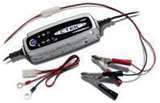10 Ways to Keep Your Car Safe and Running Smoothly Through Winter
 |
LONDON--December 16, 2011:
With winter fast approaching, CTEK, the leading developer of intelligent lead-acid Battery Chargers, has released the following ten maintenance tips to ensure that vehicles run smoothly, and safely, during the colder, more hazardous months.
1) Avoid a flat battery. Battery Maintenance
[CTEK Battery Mainenance] is essential during winter. If
you have electricity in your garage or storage area you can use a CTEK 12V Battery
Charger [CTEK: Why Charge Car Batteries] which will maintain
charge levels and keep the battery in good condition. Furthermore, certainly with new
stop-start technology present in an increasing number of vehicles, batteries are
particularly prone to flattening at a faster rate.
2) Be winter specific. It is important to ensure that you have the correct
concentration of screen wash in order to fight the elements and don't forget to add
anti freeze to your radiator. A good weather specific product such as the Farecla
Smart Rain Repellent kit is also a good idea to have handy and will dramatically
increase visibility and make driving safer.
3) Obey the maintenance schedule. You should always know and follow your
vehicle's Manufacturer's Recommended Maintenance Schedule.
4) Tyres can be deadly if ignored. Driving in winter invariably means driving in
rain, sleet and on ice and as a result, the car is running the risk of aqua planing
and skidding - it is vital to ensure that tread depth is at least 3mm to be safe in
wet or icy conditions and tyres should be inflated to the pressure recommended by the
manufacturer. Additionally, certainly in harsher climates, it's vital to ensure that
the tires aren't too old as, as they age, the rubber becomes harder resulting in a
much lower efficiency. Specific winter tires are ideal in the colder, wetter and
icier months, such as spiked and those made of rubber only.
5) Be winter aware. Cars often need more care and attention in the colder months
to keep them going - make sure that the oil in the car is an appropriate winter
weight and will not excessively thicken due to a drop in temperatures.
6) Be suspicious of smells. When your car smells funny, it may be letting you
know that something needs attention. For example, if your car smells like it's
burning rubber, you may be riding the brakes, or driving with one foot on the brake
and one foot on the accelerator.
7) Avoid excessive idling. Shut off the engine while waiting for friends and
family. Today's vehicles are designed to "warm up" fast, so forget about those long
idles on cold winter mornings.
8) Drive gently. In winter, the road conditions can be unpredictable and
dangerous if not handled correctly. Avoid sudden accelerations and jerky
stop-and-go's. During Snowy conditions always drive in the highest gear possible and
ensure that there is at least a ten second gap between you and the car in front.
9) Keep your engine tuned up. A misfiring spark plug can reduce fuel efficiency
as much as 30 percent. Follow the service schedules listed in your owner's manual.
Replace filters and fluids as recommended.
10) Brakes. Your vehicle's most critical system is its brakes. Stopping
distances are often increased during winter months due to poor weather conditions. To
combat this danger most effectively, perform tests on the brake pedal intermittently
by compressing the brake pedal lightly after driving through water or across icy road
conditions to check that it had dried out and is at its most effective.


